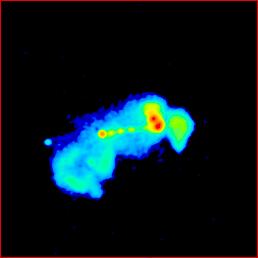 Image:
Image:3C 303 | B1441+522 |
| S178 | Alpha | FR | Class | ID | Spectrum | Best z | mag. | LAS | lg P178 | D |
|---|---|---|---|---|---|---|---|---|---|---|
| 12.2 | 0.76 | II | CD | N | 0.141 | R = 16.29 | 47.00 | 25.58 | 101.9 |

| Size: | 76.8 × 76.8 arcsec² |
|---|---|
| LUT: | Logarithmic |
| Beam: | 1.2 arcsec |
| Frequency: | 1477 MHz |
| Method: | CLEAN Õ˜ÿ>1.2
|
| Telescope: | VLA A+B |
| Credits: | Leahy & Perley (1991) |
The very distorted structure, one-sided jet, and very asymmetric hotspots, suggests that we may be viewing 3C 303 close to end on. As noted by Leahy & Perley, the polarization asymmetry suggests that the ring-like south-east lobe is the more distant, and the jet is on the near side and probably boosted by relativistic beaming. The broad-line optical spectrum is typical for such an end-on source.
Confusingly, there is a V=20.0 quasar at z=1.57, seen projected witin the radio structure, just to the south of the bright hotspot (Kronberg et al. 1976). In higher-resolution radio images (e.g. Akujor et al. 1994) there is no sign of a radio point source co-incident with the quasar, but it looks as if both it and 3C 303 are compact X-ray sources (Hardcastle & Worrall (1999). The chance of finding an unrelated quasar this close to a given point is rather low (perhaps around 0.1 to 0.2%), so this quasar-galaxy pair has been used as ammunition for the argument that AGN redshifts are not a good guide to their distances (Burbidge 1996). As in many such pairs, the quasar light shows absorption by gas at the galaxy's redshift (Burbidge et al. 1989), as expected if the quasar is in the background (but also consistent with the quasar being at roughly the same distance as the galaxy). Of course, coincidences happen, so this kind of argument stands or falls on the overall statistics, not the individual cases. In 300-odd objects in 3CR one such pair is pretty likely to occur by chance, and this is just what we find.
3C 303 has been claimed to be in a cluster, but a quantitative measurement
of the surrounding galaxy density by
Allington-Smith et al. (1993) showed only
a rather poor group, as is typical for low-redshift FR II DRAGNs.
| Prev. | Data Page | Other images | Next | Search | Alphanumeric List | Icon List | Atlas Index |
|---|